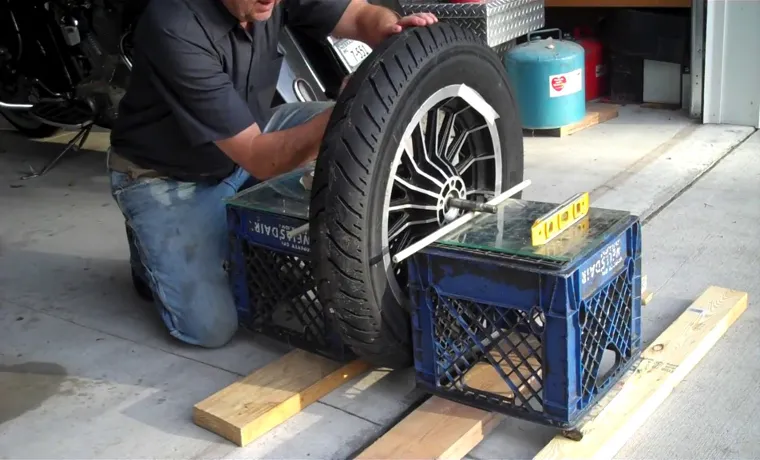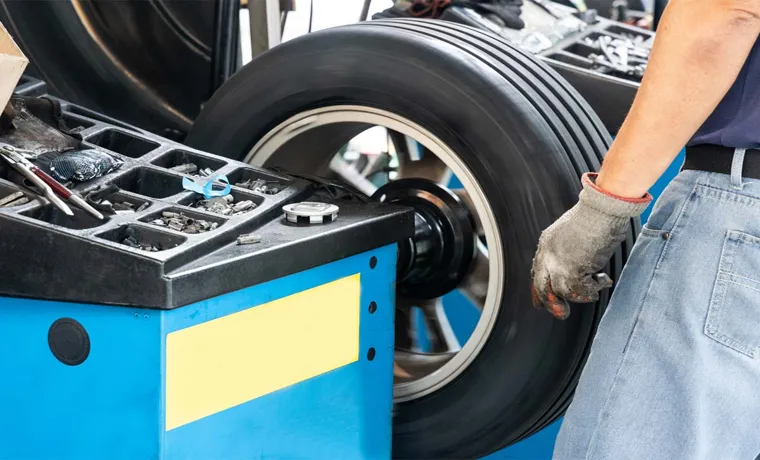Mounting and balancing your tires may seem like an unnecessary expense, but it is vital for ensuring your safety on the road. The cost of mounting and balancing can vary depending on where you go and the type of tires you have. A reputable mechanic will take the time to properly align your tires, ensuring your vehicle handles correctly and minimizing any risk of tire failure.
If you neglect to have your tires mounted and balanced, it can lead to uneven wear and tear, reduced fuel economy, and even unsafe driving conditions. In this blog post, we will discuss the cost of mounting and balancing your tires, as well as the benefits of regular tire maintenance to keep you safe on the road.
Table of Contents
Understanding Mounting and Balancing
When it comes to getting your tires mounted and balanced, prices can vary depending on where you go and what type of vehicle you have. On average, you can expect to spend around $15 to $45 per tire for mounting and balancing. However, some places may charge more for larger or more complex tires.
Mounting involves putting the tire onto the wheel and making sure it is aligned correctly. Balancing ensures that the tire spins evenly when the car is driving, which helps to prevent vibration and uneven wear. Improperly mounted or balanced tires can lead to a rough ride, decreased fuel efficiency, and even dangerous situations on the road.
While it can be tempting to go for the cheapest option, it’s important to make sure that the job is done properly for the safety and longevity of your vehicle.
What is mounting?
Mounting is a crucial process in maintaining your vehicle’s tires. The term “mounting” is used to describe the process of installing the tire onto the wheel. When you purchase new tires or have your old tires replaced, the tires need to be mounted onto the rims so that they can be installed onto your car.
During the mounting process, the tire is placed onto the wheel and then inflated to the recommended air pressure. Not only is it important to ensure that your tires are correctly mounted onto your rims, but they also need to be balanced. Balancing is the process of evenly distributing the weight of the tire and wheel assembly so that there are no vibrations or wobbling.
This ensures a smooth and safe ride. Make sure to always have your tires mounted and balanced by a professional to ensure the safety and longevity of your vehicle’s tires.

What is balancing?
Balancing is an essential process that ensures proper functioning and safety of your vehicle. Mounting and balancing refer to the steps taken to secure your tires to the wheel assembly accurately. Balancing involves adding or removing weight from the wheel to prevent it from wobbling while driving, which can cause costly damages in the long run.
It’s crucial to maintain proper balance as your car’s wheels can quickly become unbalanced due to heavy use, natural wear and tear, and other factors. A tire that is out of balance can cause vibrations, causing additional stress to your vehicle. Thus, it’s important to ensure your wheels are balanced to avoid affecting comfort and safety.
A certified technician can inspect and diagnose any wheel balancing issues and perform the necessary steps to maintain and improve performance. Don’t overlook the importance of balancing in maintaining your vehicle’s performance and safety.
Factors Affecting the Cost
When it comes to getting a tire mounted and balanced, the cost can vary depending on a few factors. Firstly, the type of tire can affect the cost. If you have a larger tire or a specialty tire, it may cost more to mount and balance it.
Secondly, the location of the service can affect the cost. If you go to a dealership or a specialty shop, the cost may be higher than going to a regular auto shop. Thirdly, the cost can vary depending on the labor rate of the service provider.
Some shops may charge a higher labor rate than others, which can affect the price. Lastly, if you need any additional services such as an alignment or new valve stems, this can add to the cost. Overall, the cost to mount and balance a tire can range anywhere from $20 to $100 or more, depending on these various factors.
It’s always best to shop around and compare prices to ensure you’re getting a fair deal for your money.
Type of tire
When it comes to buying tires, the type of tire you select can have a significant impact on the cost. There are several factors that come into play, including the tread design, size, and speed rating. High-performance tires, designed for speed and agility, typically cost more than economy tires that prioritize fuel efficiency and longevity.
The size of the tire also affects the price, with larger tires generally being more expensive. Additionally, specialized tires, such as winter or off-road tires, are typically more expensive due to their unique designs and performance features. It’s important to consider your specific driving needs and budget when selecting a tire type to ensure you get the best value for your money.
By doing your research and shopping around, you can find the right tire type for your vehicle without breaking the bank.
Type of vehicle
When it comes to determining the cost of rental vehicles, the type of vehicle you choose will have a significant impact. Larger vehicles, such as SUVs and vans, will typically cost more than smaller cars due to their increased size and capacity. Luxury and sports cars will also often come with a higher price tag due to their higher-end features and capabilities.
On the other hand, compact and economy cars are usually the most affordable options. Additionally, the age of the vehicle can also play a role in determining its cost. Newer vehicles will typically cost more to rent than older models due to their updated technology and features.
However, older vehicles that are well-maintained can still be a cost-effective rental option. So, when selecting a rental vehicle, it’s important to consider your specific needs and budget to find the best option for you.
Location and shop
When it comes to the cost of a repair or service, the location and shop you choose can make a significant impact. Different areas have varying living costs, which can affect the hourly rates of technicians and overhead costs of operating a shop. For instance, a shop in a big city with a high cost of living could charge more compared to one in a rural area with lower living costs.
Additionally, the type of shop you choose can impact the price. Dealerships may charge more than independent shops, as they typically use parts from the original manufacturer and often have higher overhead costs. However, independent shops can also vary in price depending on their level of specialization.
Shops that specialize in luxury or high-end cars may have higher rates than those that focus on more common vehicles. It’s essential to do your research and shop around for the best quote that fits within your budget. Remember, the cheapest option isn’t always the best as quality work can save you money in the long run.
Average Cost of Mounting and Balancing Tires
If you’re wondering how much it costs to have your tires mounted and balanced, the answer can vary depending on where you go and the type of vehicle you drive. On average, the cost can range from $15 to $75 per tire. It’s important to note that some shops may offer package deals that include mounting and balancing, as well as other services such as alignment and rotation.
If you’re purchasing new tires, many retailers may provide these services for free or at a discounted rate. When it comes to finding the right price for your needs, it’s always a good idea to shop around and compare prices from different shops. Additionally, it’s important to ensure that the shop you choose has experienced technicians and uses high-quality equipment to ensure your safety and the longevity of your tires.
Estimated cost range
If you’re in the market for new tires, it’s important to factor in the cost of mounting and balancing them. The average cost for these services can vary depending on a few factors, such as the type of vehicle you have and the type of tires you’re purchasing. On average, you can expect to pay anywhere from $20 to $100 per tire for mounting and balancing, which can add up to a significant expense if you’re replacing all four tires.
However, it’s important to remember that these services are crucial to ensuring a smooth and safe ride, as unbalanced tires can lead to uneven wear and tear, affecting the overall performance of your vehicle. While it may seem like an added expense, it’s well worth it to invest in the proper installation of your new tires to ensure a comfortable and safe ride.
Factors affecting the cost
The average cost of mounting and balancing tires can vary depending on a variety of factors. The type of vehicle, the size of the tires, the quality of the tires, and the location of the auto shop can all play a role in determining the price. On average, mounting and balancing a tire can cost anywhere from $20 to $100 per tire.
Certain specialty vehicles, such as sports cars or heavy-duty trucks, may require specialized equipment and techniques, which can increase the price even further. Additionally, higher-quality tires may come with a higher price tag for mounting and balancing. It is always a good idea to shop around and compare prices from several auto shops to ensure that you are getting a fair price for the services you need.
One way to save money on mounting and balancing is to purchase your tires from a shop that offers free or discounted mounting and balancing services with the purchase of new tires. Ultimately, the cost of mounting and balancing your tires will depend on a variety of factors, so it is important to do your research to find the best price for your needs.
Additional Charges and Fees
A common question when getting new tires is “how much to mount and balance a tire?” The truth is that the cost varies depending on where you go, as well as any additional charges or fees that may be added. Mounting and balancing typically range from $20-$100 per tire, again depending on the shop. However, it is important to consider any additional charges such as disposal fees, valve stems, or tire pressure sensors that may not be included in the initial quote.
These fees can add up quickly, so it is important to ask about them upfront to avoid surprises when you receive the final bill. It is also worth noting that some shops may offer package deals that include mounting and balancing as well as other services, so it’s always a good idea to shop around and do your research before deciding where to have your tires mounted and balanced.
Valve stems, disposal fee etc.
When it comes to purchasing tires, it’s important to not only consider the cost of the tires themselves, but also additional charges and fees that may be added on. One common fee is the disposal fee, which covers the cost of properly disposing of your old tires when you purchase new ones. This fee varies depending on the tire retailer and can range from a few dollars to over $20 per tire.
Another additional charge to be aware of is the valve stem fee. Valve stems are the small components that allow air to be pumped into the tire. While they may seem like a small expense, the fee for each valve stem can add up quickly, especially if you are purchasing multiple tires.
It’s important to ask your tire retailer about these fees upfront so that you can factor them into your overall budget. By doing so, you can avoid any unexpected surprises when it comes time to pay for your purchase.
Final Thoughts
If you’re wondering how much it costs to mount and balance a tire, the answer can vary depending on a few factors. Typically, the cost can range anywhere from $20 to $100 per tire. The price can fluctuate depending on the type of tire, the size of the tire, and the location of the service center.
It’s important to get a quote from a few different service centers to compare prices and find the best deal. Mounting and balancing your tires is a crucial part of keeping you and your vehicle safe on the road. Properly mounted and balanced tires can improve handling and reduce the risk of accidents.
So, although it may cost a bit of money, the investment is well worth it.
Conclusion
In conclusion, the cost to mount and balance a tire can vary depending on the type of vehicle and tire, but it’s a small price to pay for the peace of mind and safety that comes with properly installed tires. It’s like investing in a good pair of shoes – you may have to pay a little extra, but the comfort and longevity make it all worth it. So, the next time someone asks how much it costs to mount and balance a tire, just remember: it’s a small fee for a smooth and safe ride!”
FAQs
1. What is the average cost to mount and balance a tire? A: The average cost to mount and balance a tire typically ranges from $20 to $30 per tire. 2. Does the cost of mounting and balancing a tire vary by location? A: Yes, the cost of mounting and balancing a tire can vary depending on the location and the service provider. 3. Are there any additional fees associated with mounting and balancing a tire? A: Some service providers may charge additional fees for disposing of the old tire, valve stems, TPMS kits, or other necessary parts. 4. How long does it take to mount and balance a tire? A: On average, it takes about 45 minutes to an hour to mount and balance a single tire. 5. Can I purchase tires online and have them mounted and balanced at a service center? A: Yes, many service centers offer mounting and balancing services for tires purchased online. 6. Is it necessary to balance all four tires, or can I just balance the ones that need it? A: It is recommended to balance all four tires, as unbalanced tires can cause unnecessary wear and tear on other parts of the vehicle. 7. Can I mount and balance tires myself, or should I take it to a professional? A: While it is possible to mount and balance tires yourself with the proper equipment and knowledge, it is generally recommended to have it done by a professional for optimal safety and performance.



